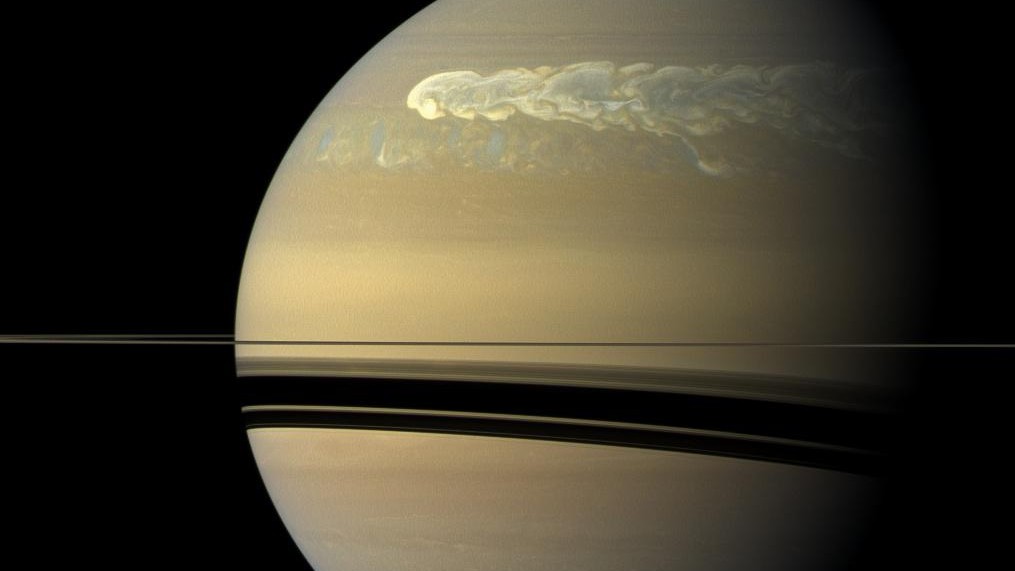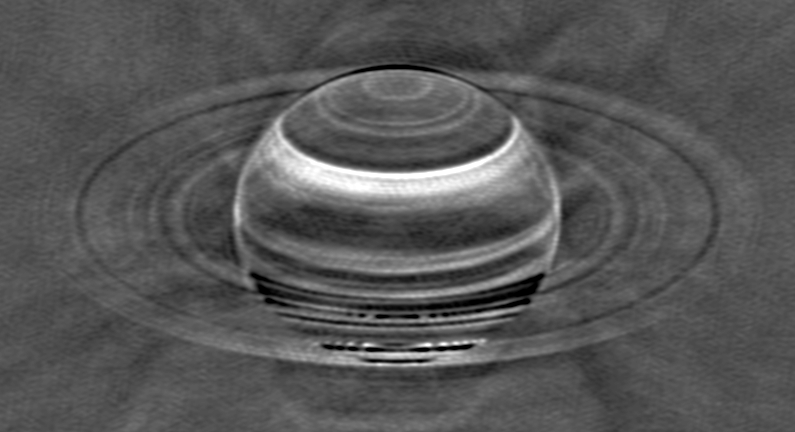100-year-long 'megastorms' on Saturn are creating radio signals that scientists can't fully explain
Gargantuan storms on Saturn can wrap around the entire planet and be seen for months. New research suggests their impacts persist hundreds of years longer than experts thought.

Imagine a thunderstorm so massive that its dark outline wrapped around the entire planet.
Such terrifying "megastorms" are common on Saturn. Also called "Great White Spots," they erupt once every 20 or 30 years in the planet's northern hemisphere and rage nonstop for months. Astronomers have spotted six of these planet-wide storms whipping around on Saturn since 1876. The most recent storm struck in December 2010, when NASA's Cassini spacecraft happened to be orbiting the planet, snagging a front-row view of the megastorm's entire 200-day life span.
Now, new research into the epic 2010 storm has found that those 200 days of thunder were just a few drops in a much bigger, weirder meteorological bucket. According to recent radio telescope scans, the ongoing impacts of megastorms that erupted on Saturn more than 100 years ago are still visible in the planet's atmosphere today, and they left behind persistent chemical anomalies that scientists can't fully explain.
In other words, long after a megastorm fades from view, its impact on Saturn's weather lasts centuries.
"For most of the time, Saturn's atmosphere looks hazy and featureless to the naked eye in contrast to Jupiter's colorful and vibrant atmosphere," the researchers wrote in a study published Aug. 11 in the journal Science Advances. "This picture changes when we look at Saturn using a radio eye."
Related: Strange radio signals detected from Earth-like planet could be a magnetic field necessary for life
Using the Very Large Array radio telescope in New Mexico, the study authors peered through the haze of Saturn's upper atmosphere, hoping to find chemical remnants of the vast 2010 megastorm. In fact, the team found traces of all six recorded megastorms, the earliest of which hit more than 130 years ago, as well as a potentially new storm never recorded before.
Get the world’s most fascinating discoveries delivered straight to your inbox.
Visible only in radio wavelengths, those remnants took the form of large ammonia gas anomalies. Saturn's uppermost cloud layer is made mainly of ammonia-ice clouds. But in their radio observations, the researchers saw regions of unexpectedly low ammonia concentrations just below this cloud layer in areas associated with past storms. Meanwhile, hundreds of miles below these same atmospheric regions, ammonia concentrations spiked much higher than normal.
The implication, according to the study authors, is that megastorms appear to drive some mysterious ammonia transport process that drags ammonia gas from Saturn's upper atmosphere into the depths of the lower atmosphere — possibly in the form of a "mushball" rain in which icy hail balls of ammonia fall through the atmosphere before reevaporating again. This mushy process appears to last hundreds of years after a storm visibly vanishes, the researchers wrote.
While the mechanisms behind these atmospheric anomalies — and behind Saturn's megastorms in general — remain a mystery, studying them further could broaden not only our understanding of how giant planets form but also of what drives storm systems like Saturn's Great White Spots and Jupiter's even larger Great Red Spot to grow so inexplicably large, according to the researchers.
"Understanding the mechanisms of the largest storms in the solar system puts the theory of hurricanes into a broader cosmic context, challenging our current knowledge and pushing the boundaries of terrestrial meteorology," lead study author Cheng Li, formerly at the University of California, Berkeley and now an assistant professor at the University of Michigan, said in a statement.

Brandon is the space / physics editor at Live Science. With more than 20 years of editorial experience, his writing has appeared in The Washington Post, Reader's Digest, CBS.com, the Richard Dawkins Foundation website and other outlets. He holds a bachelor's degree in creative writing from the University of Arizona, with minors in journalism and media arts. His interests include black holes, asteroids and comets, and the search for extraterrestrial life.



